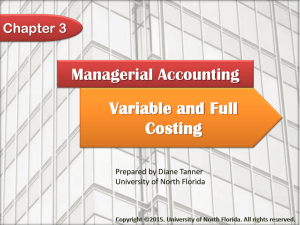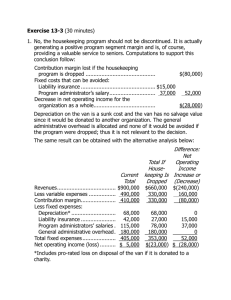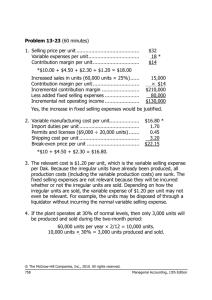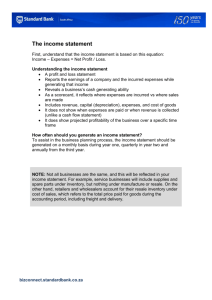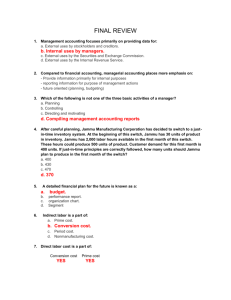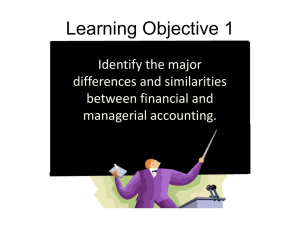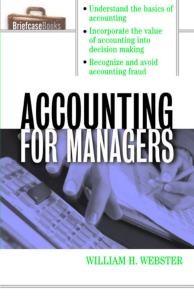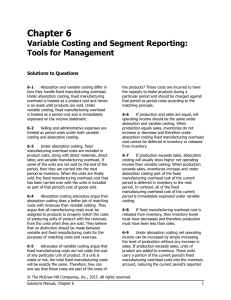Part A: Solve each of the following three problems
advertisement
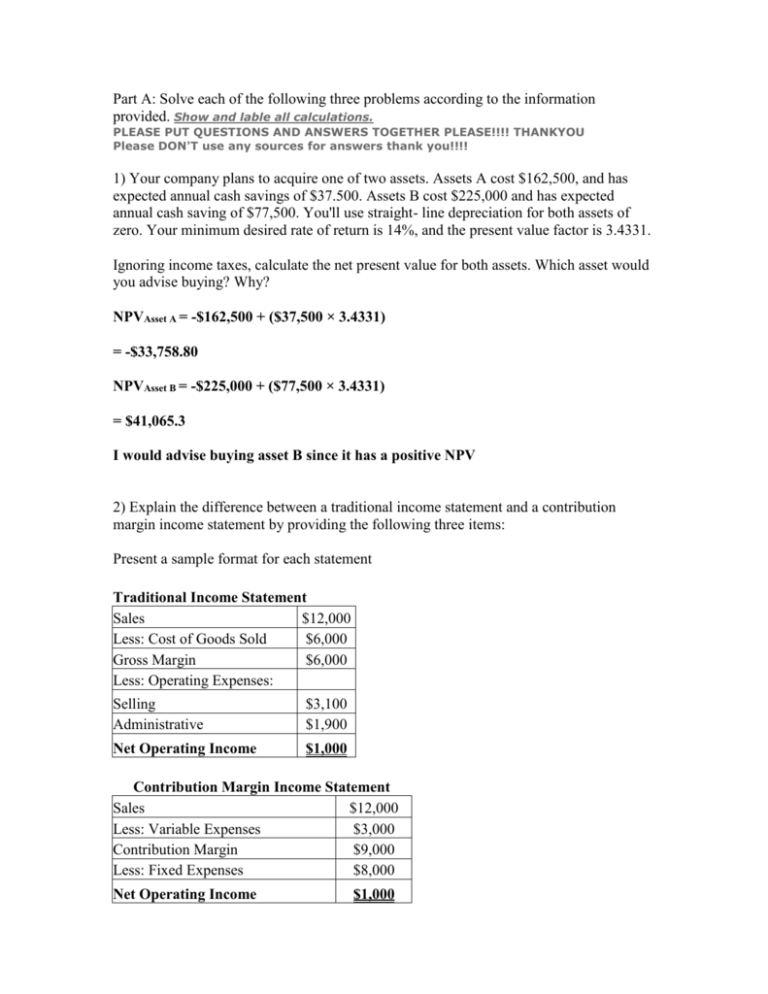
Part A: Solve each of the following three problems according to the information provided. Show and lable all calculations. PLEASE PUT QUESTIONS AND ANSWERS TOGETHER PLEASE!!!! THANKYOU Please DON'T use any sources for answers thank you!!!! 1) Your company plans to acquire one of two assets. Assets A cost $162,500, and has expected annual cash savings of $37.500. Assets B cost $225,000 and has expected annual cash saving of $77,500. You'll use straight- line depreciation for both assets of zero. Your minimum desired rate of return is 14%, and the present value factor is 3.4331. Ignoring income taxes, calculate the net present value for both assets. Which asset would you advise buying? Why? NPVAsset A = -$162,500 + ($37,500 × 3.4331) = -$33,758.80 NPVAsset B = -$225,000 + ($77,500 × 3.4331) = $41,065.3 I would advise buying asset B since it has a positive NPV 2) Explain the difference between a traditional income statement and a contribution margin income statement by providing the following three items: Present a sample format for each statement Traditional Income Statement Sales $12,000 Less: Cost of Goods Sold $6,000 Gross Margin $6,000 Less: Operating Expenses: Selling Administrative $3,100 $1,900 Net Operating Income $1,000 Contribution Margin Income Statement Sales $12,000 Less: Variable Expenses $3,000 Contribution Margin $9,000 Less: Fixed Expenses $8,000 Net Operating Income $1,000 Describe the focus of each statement. In the Traditional Income Statement, the focus is on the functions of production, administration, and sales in the classification of cost data. No attempt is made to distinguish between the behavior of costs included under each functional heading. The Contribution Margin Income Statement, the focus is on the behavior of costs. This emphasis on costs by behavior facilitates cost-volume-profit analysis. Discuss how and by whom each statement is used. The Traditional Income Statement is mainly used by external users since such users (bankers, investors,…etc) are mainly interested in bottom line net income, profitability (gross profit margin, profit margin...etc), as well as calculating the percentage of expenses to revenues; they do not use such statement for planning. The Contribution Margin Income Statement on the other hand is used by Internal users since they need cost data for planning, performance appraisal as well as in budgeting. 3) Answer 3 based on the following info: Jan -Feb - Mar -Quarterly totals Project sale , 450,000 , 425,000 , 550,000 , ? price per unit ,? ,? ,? ,? total project sales $463,500 ? ? ? Calculate the totals project sales for the quarter. ( Round your answer to the nearest dollar) Projected Sales Price per Unit Total Projected Sales January 450,000 $1.03 $463,500 February 425,000 $1.03 $437,750 March 550,000 $1.03 $566,500 Quarterly Totals 1,425,000 $1.03 $1,467,750 Part B: Answer each of the following 10 Questions according to the information provided. Show and lable all calculation. 1) At the local ice cream shop, there's a sign posted that reads, "If you don't receive a receipt, your next ice cream is free!" Is this an internal control procedure? If so, how dose it work? Yes, this is an internal control procedure since by implementing this policy, the company ensures that all sales are properly recorded and documented. If a mistake is made and the customer is not given a receipt, he is the one who will report the error. 2) How do job costing, operations costing, and process costing differ? Provide two typical examples of products or organizations for each system. Job Costing is used in situations where many different products are produced each period. Job Costing is also used in service industries such as hospitals, law firms, accounting firms, and repair shops. Operations Costing is used in situations where products have some common characteristics and also some individual characteristics. It is a hybrid system that employs aspects of both Job and Process Costing. Products are typically handled in batches when Operations Costing is in use. Examples of products that would employ this type of costing are: shoes, textiles, and clothing. Process Costing is used in industries that produce homogeneous products on a continuoes basis such as paper, and bricks. 3) GL, Inc. has two product divisions. Division G sells a product with a selling price per unit of $100, variable expenses per unit of $54, and traceable fixed expenses of $142,000. Division G produced and sold 45,000 units of the product. Common fixed expenses for GL, Inc. were $250,000. Prepare a segmented income statement for Division G showing the profit if common cost are allocated equally between the company's division. GL, Inc. Segmented Income Statement Total Company Division G Sales $4,500,000 Less: Variable Expenses $2,430,000 Contribution Margin $2,070,000 Less: Traceable Fixed Expenses $142,000 Divisional Segement Margin $1,928,000 Common Fixed Expenses $125,000 Net Operating Income $1,803,000 4) Your company acquires production equipment by trading an older machine and giving the seller 100 shares of company stock. How should this transaction be reported on the statement of cash flows? The transaction is reported under the Noncash Investing and Financing Activities section of the statement of cash flows. 5) A manufacturer is developing a new type of vacuum cleaner that will have a target price of $450. To maintain a target profit equal to 35 percent of the new product's cost, what will the target cost be? Target Cost = Target Price – Target Profit Let the Target Cost be C C = $450 – 0.35C 0.35C + C = $450 1.35C = $450 C = $450/1.35 = $333.33 6) You overhear the manager of a sing shop say, "I'd never accept a special order! How could you ever make money selling products below full cost?" Do you agree? Why or why not? I do not agree because a Special Order should be accepted even if it is below the full cost as long as the incremental revenue from the special order exceeds the incremental cost of the order. 7) The accounts receivable ratio for a physician is 5.75, and sales are in receivables an average of 63.48 days. Are these ratios positive? Why or why not? This question cannot be answered unless we know the average industry figures. Ratios cannot be interpreted in isolation. The ratios has to be compared either to previous periods ratios for the same physician, or to industry standards. Still, judging from the field the physician is working in, the ratios do not seem positive; this is because the turnover figure indicates that the physician was able to collect his outstanding receivables and created new receivables 5.75 times only through the year, the same is true for the average collection period which indicates that it usually take the physician 63.48 days to collect the amounts due from patients which is quite long. On the other hand, the length of the collection period could be attributed to the fact that most physicians are working with insurance companies which usually take some time for processing claims and payments. 8) Gantt Textiles Inc. incurred actual variable overhead expenses of $50,000 in the current year for the production of 6,000 units. Variable overhead was applied at a rate of $3.25 per direct labor hour, and 2 direct labor hours were budgeted for each unit. The company used 16,000 direct labor hours for production. Compute the variable - over head spending variance and the variable - overhead efficiency variance. Indicate whether each variance is favorable (F) or unfavorable ( U ). Spending Variance = Actual Variable Overhead Expense – (AH × SVR) = $50,000 – (16,000 × $3.35) = -$3,600 Unfavorable Spending Variance for 3,600 Efficiency Variance = (AH × SVR) – (SH × SVR) = (16,000 × $3.35) – (6,000 × 2 × $3.35) = $13,400 Favorable Efficiency Variance of 13,400 9) Briefly describe and draw a diagram of the cost accumulation process for a traditional manufacturing company Costs Product Costs Balance Sheet 1) Raw Materials Purchases Raw Materials Inventory 2) Direct Labor Direct Materials Used in Production 3) Manufacturing Overhead Work in Process Inventory Goods Completed (Cost of Goods Manufactured) Income Statement Cost of Goods Sold Period Costs Finished Goods Inventory Selling and Administrative Selling, and Adm. Expenses The cost accumulation process of a traditional manufacturing company starts with calculating transferring the direct materials costs into the Raw Materials Inventory account on the balance sheet, the direct labor and manufacturing overhead costs are then added to the Work in Process Inventory on the balance sheet, and the cost of direct materials used in production is also transferred from the Raw Materials Inventory unto the work in process inventory. The cost of Goods completed are then transferred into the Finished Goods Inventory on the balance sheet. Next, the amount of cost of goods sold are deducted from the FG inventory and transferred to the Cost of Goods Sold on the Income Statement; and finally the Period Costs (Selling and Administrative expenses) are transferred to the Income Statement.

